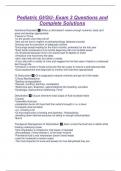Pediatric GI/GU- Exam 3 Questions and
Complete Solutions
Nutritional Disorders ✅-When a child doesn't receive enough nutrients, body can't
grow and develop appropriately
-Failure to Thrive
*on the growth chart they fall off
*also can be due to neglect or pathophysiology (disease process)
-Nursing care for promotion of adequate nutrition
*Encourage breast-feeding for the first 6 months, preferably for the first year
*Solid foods introduced at 4-6 months beginning with iron-fortified cereal
>Is introduced because mom's iron stores start to deplete to infant
>Introduce one food every few days
>don't start with all fruits, but rather a variety
>If you start with a variety of fruits and veggies the first few years it leads to a balanced
diet through life
*Introduce a variety of foods during the first two years to ensure a well balanced diet.
-Good assessment and diagnostic to monitor and intervene appropriately
GI Dysfunction ✅-GI is supposed to absorb nutrients and get rid of the waste
-Clinical Manifestations
*Spitting up/regurgitation
*Nausea, vomiting, diarrhea, constipation
*Abdominal pain, distention, gastrointestinal (GI) bleeding, Jaundice
*Dysphagia, dysfunctional swallowing, Fever
Dehydration ✅-Occurs whenever total output of fluid exceeds intake
-Causes
*Insensible fluid loss
>metabolism burns off more fluid than what's brought in i.e. a fever
*Increased renal excretion
>I.e. urinating a lot
*GI tract dysfunction (vomiting and diarrhea), *Ketoacidosis
>breaking down ketones because not taking in enough carbohydrates
*Burns
Therapeutic Management of Dehydration ✅-Goal: correct the fluid loss or deficit while
treating underlying cause
*Oral rehydration is initiated for mild cases, if tolerated
>like pedialyte, if they tolerate it, is the least invasive
*Parenteral fluid is oral rehydration doesn't meet needs
>used for moderate to severe cases
-The most important to know and assess for how dehydrated they are
,Accurate of intake and output ✅-Urine and stools (amt., color, consistency, time)
*1 gram of wet diaper weight equals 1 ml of urine
-Vomitus (amt., color, consistency, time), Sweating (will need extra fluids_
-Daily weights - best indicator of fluid balance
*same scale each time and weigh at same time each day, wearing the same thing
-Fontanel in infants
*Sunken in dehydrated infants
*anterior fontanel will be sunken in if dehydrated
Diarrhea ✅-Can lose a lot of fluid from this
-Acute diarrhea is leading cause of illness in children <5 years of age
-Diarrheal disturbances have several forms:
-Gastroenteritis (stomach and intestines)
*Inflammation
-Enteritis (small intestines)
*Inflammation
-Colitis (colon)
*Inflammation
-Enterocolitis (colon and intestines)
*Inflammation
Types of Diarrhea ✅-Acute - sudden increase in frequency and change in consistency
*stool is liquid, will stop on its own
of stools, usually self limiting (<14 days)
-Acute infectious/infectious gastroenteritis - acute diarrhea caused by infectious agent
(viral, bacterial, and parasitic) in GI tract
-Chronic - an increase in stool frequency and increased water content with a duration of
more than 14 days, often caused by chronic conditions (malabsorption syndromes,
inflammatory bowel disease, etc.)
-Intractable diarrhea of infancy - occurs in first few months of life, persists no more than
2 weeks
-Chronic nonspecific diarrhea (CNSD) - irritable colon of childhood and toddler's
diarrhea, loose stools, often with undigested food particles, lasting no more than 2
weeks
Causes of diarrhea ✅-Rotavirus
*Not very common in the U.S. due to vaccine
*In 3rd world countries is the leading cause of diarrhea and death in infants
-Salmonella, Shigella, Campylobacter organisms - most frequently isolated bacterial
pathogens
-Giardia organisms
-Cryptosporidium organisms
-Clostridium difficile
*kids and adults
-Antibiotic effects
*kicks out not only the bad bacteria but also the good from the GI and causes diarrhea
, Therapeutic management of Diarrhea ✅-Assessment of fluid and electrolyte imbalance
*will do labs looking at sodium, potassium, and all electrolytes
*If anything is missing, will monitor and replace if necessary
-Vitals Signs: avoid rectal temp
*Inflammation, can lead to damage
-May be NPO to rest bowel
*eating food can causes further inflammation and more diarrhea and worsen the issue
-Rehydration
*Oral rehydration therapy (ORT) ex. Pedialyte
>Oral rehydration solutions enhance and promote resorption of sodium and water
*Intravenous rehydration Maintenance of fluid therapy
*Assess is child mildly dehydrated or moderate/severe
-Reintroduction of an adequate diet
*bland food and then back to the normal diet when tolerated
-Antidiarrheal, antibiotics, antiprotozoal as ordered
-Skin care of diaper area
*the diarrhea is acidic and will cause breakdown of the skin
Goals of therapy for diarrhea ✅-Assessment shows moist mucous membranes, elastic
skin turgor (they are getting enough hydration)
-Urine specific gravity of 1.005-1.020
-1-2 ml/kg/hr of urine output
-Child is free of frequent loose stools (soft, formed stools of less than 4 per 24 hours)
-Free of vomiting
-Tolerates regular diet
-Maintains skin integrity
Vomiting ✅-Often accompanied by nausea
-Color and consistency vary according to etiology:
*Green bilious suggests bowel obstruction
*Curdled stomach contents, mucus, or fatty foods vomited several hours after ingestion
suggest poor gastric emptying
*Appearance of coffee grounds (due to blood being mixed with stomach contents)
suggests GI bleed
>black stool
Management of vomiting ✅-Therapeutic management
*Detection and treatment of cause (underlying)
*Fluids given in same way as in diarrhea
>mild PO and moderate/severe: IV
*Antiemetic drugs may need to be given
-Nursing care management
*Observing and reporting vomiting
>describe accurately
*Position on side or semi reclining to prevent aspiration




